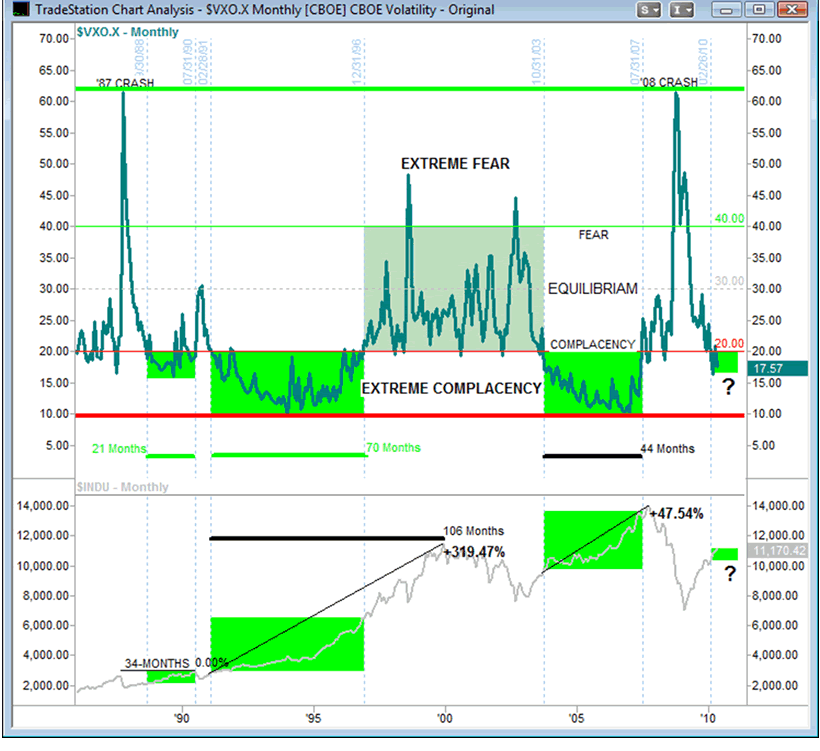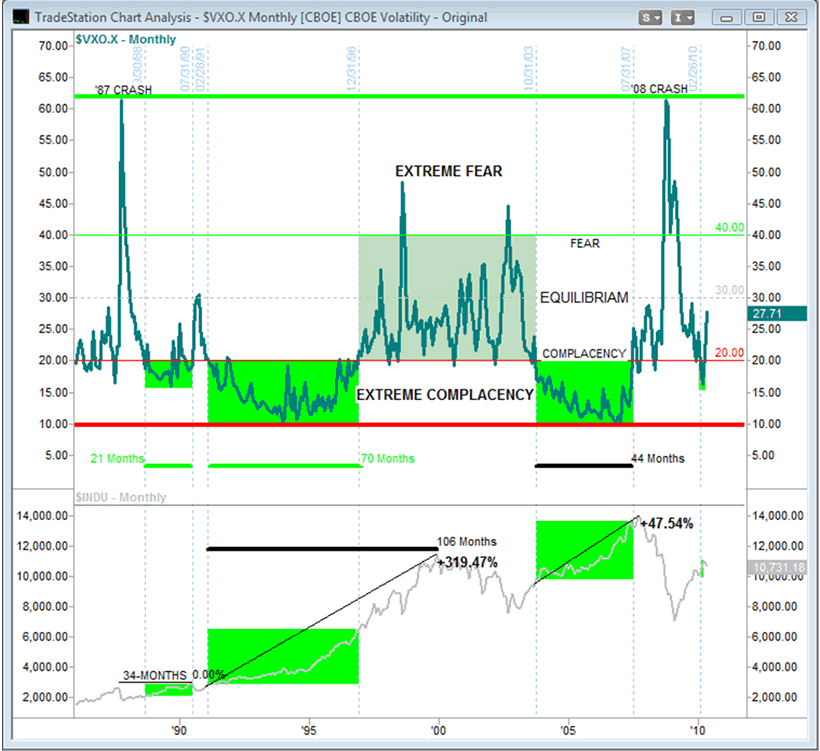The Stock Market Fix is in the VIX
Stock-Markets / Volatility May 14, 2010 - 02:39 AM GMTBy: Joseph_Russo
 To measure the ongoing success or failure of massive QE "working groups" interventions, all one needs to keep an eye on is the VIX. Readings below 20 suggest, "The FIX is in", whereas readings above 20 diminish the mission control effort to reflate monopoly-saving bubbles.
To measure the ongoing success or failure of massive QE "working groups" interventions, all one needs to keep an eye on is the VIX. Readings below 20 suggest, "The FIX is in", whereas readings above 20 diminish the mission control effort to reflate monopoly-saving bubbles.
In effort to maintain control of supreme monopolies, policy makers and monetary authorities have successfully fostered an egregiously false paradigm of ever-rising paper asset values in setting policy and enacting legislation that in effect "FIXES the VIX" to extraordinarily low levels. This fuels rampant speculation, and excessive risk taking without regard for useful gains in productivity and the real economy over the medium or long-term.
Contrarians have historically viewed traditional VIX readings below 20 as excessively bearish, although as highlighted in the green timeframes in the chart below, readings beneath 20 have been quite the “norm” in recent decades.
Conversely, prolonged and/or extremely high readings toward 40 indicate a high degree of anxiety and fear. Contrarian options traders regard such high readings as bullish.
Those orchestrating the so-called "great moderation" have succeeded in keeping the VIX beneath the 20 level for a whopping 48% of the time over the past 24-year time horizon. Doing so was complete MADNESS. The result of such folly clearly goes long way in explaining frequent occurrences of the sheer insanity displayed throughout the financial markets in recent years.
Flawed monetary policy amongst other legislative measures has provided accommodation for inordinate levels of complacency for extended periods, and has proven to engender more frequently acute bubbles and busts. In our view, this lunacy has reached a point of no return whereby rampant speculative bubbles are the only means by which authorities can hope to sustain themselves as viable.
In our view, past periods of the so-called great moderation was nothing more than a gargantuan failure of epic proportion. Since leadership continues to double-down - going ALL-IN with an endless supply of manufactured fiat, there is no resolution to the paradox beyond continuing to foster such policies in perpetuity. Sadly, this is where we find ourselves today.
With the exception of a very brief respite in 1990-1991, following the crash of '87, the VIX remained excessively bearish from a contrarian perspective (beneath the 20-level) for nearly eight years. That is a long time to maintain contrarian disciplines. Harshly discredited, mainstream cast aside contrarians along with their traditional measures of fear and complacency in favor of the new (sub-20) bubble paradigm.
This set of policy-induced conditions provided for a rather unhealthy and excessive 320% gain in the Dow industrials over an extremely short nine-year period. Of course, that gain eventually blew up and totally evaporated in the crash of 2000-2002.
During the dot.com bust in 2000-2002, monetary authorities went into emergency accommodation mode once again. From 2003 - 2007 they enacted more policies inciting excessive risk-taking, which kept the VIX beneath the 20-level for another four solid years.
From 2003-2007, the Dow advanced amid an "echo bubble" racking up another straight 44 months of continual daily VIX readings below 20. This encore policy-induced echo-bubble busted even harder than the first amid the crash of 2008.
It appears the only way equity markets can continue to advance, is with the full faith and backing of an implied US Government/Federal Reserve backstop of infinite accommodation and bailout provisions.
Over the last 25-years, there have been only two episodes of outright panic. Each surpassed typical levels of fear beyond the historically accepted 40-level. Both panic readings registered prints north of 60. The first occurred amid the crash of '87, and the second most recently amid the crash of '08. Last week's mini-black swan event, which had more to do with a lack of buyers and liquidity rather than computer glitches, did not even come close to reaching the panic zone.
We began to pen this article back on May 3 when the VIX chart was appearing "traditionally bearish" but "new-false-paradigm-normal" (bullish). That is to say that the VIX had returned to producing daily closes beneath the bubble zone of safety - registering consistent daily closes beneath the 20-level. Alas, a new bubble mania had apparently begun to manifest amid the persistent V-Shape recovery rally off the March 2009 low.
We rendered the 3-May chart below as this article began to take shape. Before we could finish the piece, 6-May had come and gone.
3-May 2010

6-May 2010:
Mini-Black Swan event rocks the daily close on the VIX well north of its safe bubble-zone beneath 20, but nowhere near level s of fear let alone outright panic. In fact, the closing VIX on 6-May had barely reached a level of balance or equilibrium (30) between fear and complacency.
10-May 2010

Traditionally high VIX readings (40+) usually occur after an extended or sharp decline while sentiment is still quite bearish. Historically, contrarians view high readings toward the 40 level as bullish. As such, it is reasonable to conclude that markets are in a balanced state of equilibrium at VIX readings close to the 30 level.
Conflicting signals between VIX and the market can also yield sentiment clues for the short term. If the market declines sharply and VIX remains unchanged or decreases in value (towards complacency), it could indicate that the decline has further to go. Contrarians might take the view that there is still not enough bearishness or panic in the market to warrant a bottom. If the market advances sharply and VIX increases in value (towards panic), it could indicate that the advance has further to go. In such an instance, contrarians might take the view that there is not enough bullishness or complacency to warrant a top.
In the mind of mainstream financial media, fixed VIX readings beneath 20 (excessively bearish and overly complacent) are "the new (bubble-permitting) normal" that ignorant cheerleaders applaud. To pursue and lobby for such policies of accommodation that foster such readings is foolish, self-destructive, and ultimately suicidal.
In closing, the only way the perpetual denial-based extend and pretend policy wins is with sustained and extended periods of VIX readings beneath the 20-level. Sustained VIX readings above 20 shall exacerbate the already terminal problems occurring at mission control.
By Joseph Russo
Chief Publisher and Technical Analyst
Elliott Wave Technology
Email Author
Copyright © 2010 Elliott Wave Technology. All Rights Reserved.
Joseph Russo, presently the Publisher and Chief Market analyst for Elliott Wave Technology, has been studying Elliott Wave Theory, and the Technical Analysis of Financial Markets since 1991 and currently maintains active member status in the "Market Technicians Association." Joe continues to expand his body of knowledge through the MTA's accredited CMT program.
Joseph Russo Archive |
© 2005-2022 http://www.MarketOracle.co.uk - The Market Oracle is a FREE Daily Financial Markets Analysis & Forecasting online publication.



